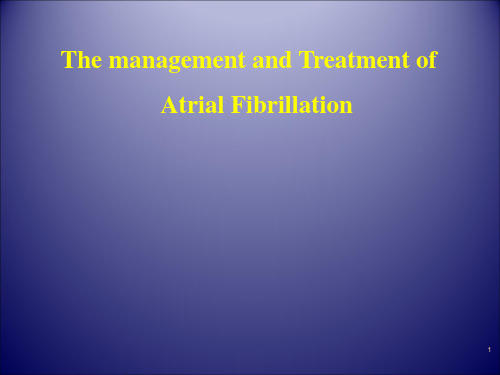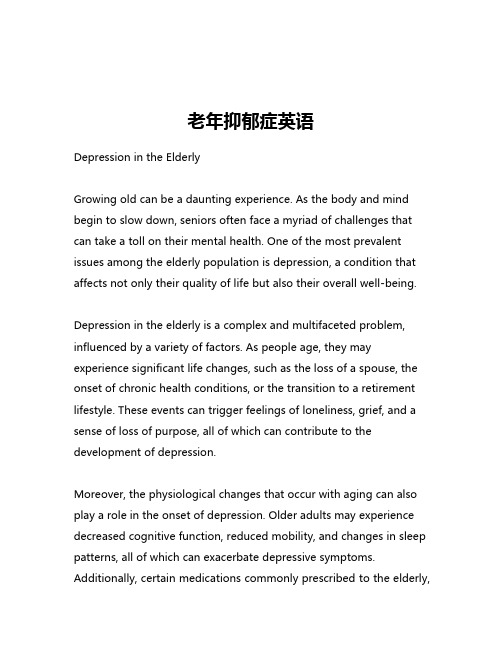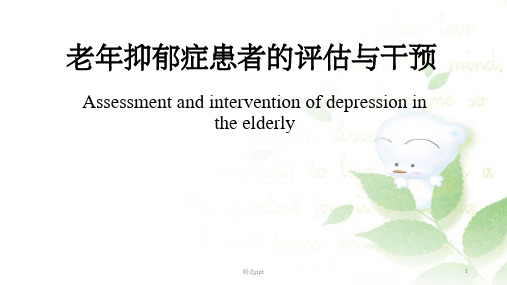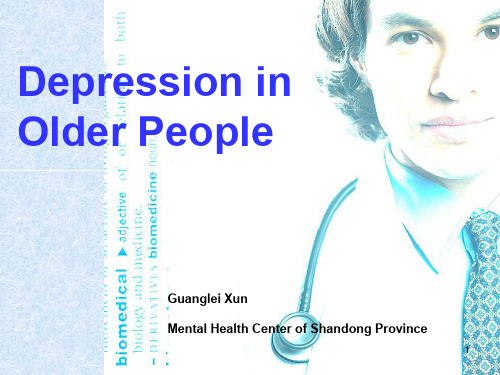老年病学英文课件:Dyslipidemia in elderly
老年病学英文课件:房颤

HBP
3.4
CHD
2.4
no stroke with stroke
CHF
AF
4.3
4.8
P<0.001
AF:Atrial fibrillation;CHD:Coronary heart disease;
CHF: congestive heart-failure;HBP: hypertension
12
female
male 10
11.1 10.3
9.1
8 morbidity (%)
6
Patients with AF,N = 17,974
Go et al. JAMA 2001;285:2370-5
7.3 7.2
5.0
5.0
4
3.0
3.4
2
1.7
1.7Biblioteka 0.9 1.00.1 0.2 0.4
0
< 55
may speed the process.
• The incidence of atrial fibrillation in the elderly is high, also
the incidence of stroke in elderly patients with atrial fibrillation is higher.
12
Conditions predisposing to, or encouraging progression of AF
13
1. Rate and rhythm control strategies
14
Ventricular rate control strategies is still become priority as there is no effective rhythm control methods
老年性痴呆流行病学培训课件

老年性痴呆流行病学
27
此外,许多疾病都可以引起老年期痴呆,据 统计有100余种(见本书184页)
老年性痴呆流行病学
28
老年性痴呆的预防措施
一、预防策略
1.应充分认识人口老龄化和老年性痴呆对我国社会 经济发展和医疗保健事业带来的巨大挑战。
错综复杂的关系。研究测定AD患者与正常对照组 的外周血胰岛素和Aβ水平发现AD患者血胰岛素水 平明显高于对照组,并与Aβ水平相关。因常见慢 性病2型糖尿病(DM2)存在胰岛素抵抗和胰岛素 绝对水平的升高,同时有研究提示AD与DM2之间有 一定的关联,这一方向已成为一些学者研究的新 热点。
老年性痴呆流行病学
(95%可信区间为1.4~9.9)。
老年性痴呆流行病学
23
4.血管性因素
长期观察性研究发现中年期高血压与晚年
痴呆和AD发病危险性增加有关联。神经病理学
研究亦支持高血压与AD的特征性病理改变有联
系。而一些相对短期随访研究未发现高血压与
AD有任何关联,甚至低血压可能与痴呆和AD高
发病危险性有关。目前认为,血压不仅与痴呆
老年性痴呆流行病学
2
痴呆是一个症状群,由不同的疾病引起,按其 病因可分为4大类:变性病性、血管性、感染性和 代谢性疾病引起的痴呆。
变性病性痴呆(degenerative dementing disease)主要包括:阿尔茨海默病(Alzheimer disease,AD)、额颞叶痴呆(皮克病和皮克综合 征)、路易体痴呆病(Lewy body disease)、帕 金森病合并痴呆、皮质基底节变性 (corticobasal degeneration)等
阿尔茨海默病(老年病)优质PPT课件

• 英国Martin Roth(1978)的研究,AD患病 率为6.2%,以后多数研究结果都较一致, 在5% ~ 8%之间,女性约为男性的2~3 倍。AD是一个与年龄相关的疾病,患病率 随年龄增长而稳定上升,Evans等报道 (1989)65~74岁患病率为3%,75~84岁 患病率为19%,超过85岁为47%。但最老 人群患病极限率是否继续攀升或是最终下 降还不清楚。
急性起病
2
Hachinski
波动性病程
2
缺血量表
人格相对保持完整 躯体诉说
1 1
有高血压或既往史
1
动脉硬化
1
局灶性神经体征
2
局灶性神经性症状
2
阶梯式恶化
1
夜间意识模糊
1
情绪低落
1
情感失禁
l
中风史
2
总分在7分以上者提示可诊断为血管性痴呆,4分以下可应考虑阿尔茨海默病
(七) Treatment • 目前尚缺乏特殊的病因治疗
(三) Pathology
病理学的改变在AD的诊断 及研究中有极为重要的意义。
1.大体结构
常可见不同程度的大脑皮质 弥漫性萎缩。脑回变平,脑沟 增宽,脑室扩大,脑组织重量 减轻。这种改变在颞、顶、前 额和海马区最明显,发病年龄 早者改变尤为突出。
2.显微结构
在显微镜下主要的病理改变为神经纤 维变性、消失和特征性的老年斑及神 经元纤维缠结三个方面。
• 包括边缘叶 • 杏仁核 • 丘脑前核 • 乳头体核 • 丘脑下部等结构
乳头体 核
阿尔茨海默病
Alzheimer’s disease (AD)
(一) Summarize
阿尔茨海默病(Alzheimer’s disease, 简称AD)是一种中枢神经系统原发性退 行性疾病,主要临床表现为痴呆综合征, 多缓慢起病,持续进展,病理改变以大 脑弥散性萎缩和神经细胞变性为主。
老年病学总论最新精选PPT课件

评价:以上 11项内容,每项良好为 3分,中等为 2分, 差为1分。总评价 30-33分为良好, 20-29分为中等, 11-21分为差
老年病学研究的对象与任务
? 心理卫生:评价心理卫生有33项,分为3组。 第1组:近3年14项负性事件:⑴离退休⑵本人或配偶严重病伤⑶与配偶不和⑷配 偶去世⑸子女生活受挫折或病重或去世⑹与子女不合⑺父母去世⑻好友去世⑼搬 家及照顾者的变动⑽邻居不和⑾经济困难⑿财产重大损伤⒀法律纠纷⒁严重自然 灾害。 第2组:5项正负心理感受:⑴精力好,不中用了⑵高兴的事挺多,常憋闷不痛快 ⑶做完了自己想干的事心里很痛快,无事干也无人理睬⑷愿意和别人来往,不想 和别人来往⑸心胸豁达,变得小心眼,常感寂寞。 第3组:6项目前担心的事情:⑴经济困难⑵住房困难⑶住房紧张⑷看病困难⑸家 庭不合⑹物价上涨。 心理卫生良好:负性事件不超过2项,对情绪无影响,有4项以上正性心理感受, 目前无担心的事情 心理卫生中等:负性事件不超过5项,对情绪影响不严重,有2-3项正性心理感 受,有1-3项担心的事情 心理卫生差:负性事件在5项以上,对情绪有严重影响,负性心理感受4-5项, 有3项以上担心的事情。
老年病学研究的对象与任务
四、老年病学研究的任务: 老年病学的任务就是研究老年病发生的原因及相 关危险因素,老年病临床表现的特殊性、老年病 的诊断、治疗和护理、老年病的康复以及老年预 防保健等。最终目标是通过积极的临床治疗、康 复和预防,最大限度的控制老年病的发生,把老 年病的患病率、病死率、致残率、复发率降到最 低限度。同时积极开展全面的老年预防保健工作, 不断提高老年人的生命质量,以实现健康长寿的 美好理想。
老年病学英文课件:End of Life Care

How to recognise the dying patient
• Indicators of irreversible decline, gradual but progressive
– Profound weakness – Drowsy and disorientated – Diminished oral intake, difficulty taking
Speech, Dietary)
Goals of EoL care
Patients are enabled to have
a ‘good death’
1) Patients: symptoms controlled, the quality of life increased, leave peacefully
• Hospice in the USA
– Volunteer Team to provide supportive care for cancer patients.
– Medicare Hospice Benefit: 1980’s • Non-Cancer diagnoses now more frequent than cancer diagnosis for hospice care.
National Council
Place: Home Hospital Hospice CareHome
……………………………………………………………………………
Preference 56% 11% 24%
4%
Cancer 25% 47% 17%
老年抑郁性疾病课件

老年抑郁性疾病
36
特别需要强调的事情
❖ 防范自杀
一定要询问的内容 第一条医嘱:同时给患者和患者家属
❖ 病情在治疗中恶化
请会诊和及时转诊
严重自杀现状判断、既往自杀史、家族自杀史
严重症状幻觉、妄想、
严重精神运动性迟滞(木僵)
抗抑郁药规范治疗无效
合并其他精神老年障抑郁碍性疾病
37
治疗目标
减轻/消除 症状、体征
发病后症状急剧进展
❖ 病程 变化少、长期持续 日内和日间有变动
一般为进行性 持续时间短
❖ 自我能力评价 隐藏自己能力的低下 感叹自己能力低下
处世能力基本保存 处世能力经常丧失
❖ 症状
近期记忆障碍 老年近抑期郁性和疾远病 期记忆障碍
35
一、什么是老年抑郁症? 二、谁会患抑郁症? 三、老年人为什么会得抑郁症? 四、老年抑郁症有什么表现? 五、如何判断是不是得了老年抑郁症? 六、得了老年抑郁症怎么办?
淋巴瘤
L-天冬酰胺,二性霉素,干扰素)
帕金森病
地西泮
恶性贫血(维生素B12缺乏)
老年抑郁性疾病
17
病毒性疾患(如肝炎、单核细胞
病理生理变化
生化 ❖ 大脑神经突触间隙神经递质5-羟色胺
和去甲肾上腺素等含量减少、 ❖ 多巴胺受体异常 神经内分泌 ❖ 下丘脑-垂体-肾上腺素/甲状腺轴
老年抑郁性疾病
18
2.思维障碍 感到反应迟钝和注意力下降,大 多表现为应答反应迟缓、思考问题困难和主 动性言语减少。在抑郁心境下否定自己,自 我评价下降,常自责、自卑和厌世。
3.认知功能减退 80%记忆减退的主诉,常感觉
脑子反应慢了,注意力集中不起来,计算困
难,判断能力下降等等。经过系统的抗抑郁
老年抑郁症英语

老年抑郁症英语Depression in the ElderlyGrowing old can be a daunting experience. As the body and mind begin to slow down, seniors often face a myriad of challenges that can take a toll on their mental health. One of the most prevalent issues among the elderly population is depression, a condition that affects not only their quality of life but also their overall well-being.Depression in the elderly is a complex and multifaceted problem, influenced by a variety of factors. As people age, they may experience significant life changes, such as the loss of a spouse, the onset of chronic health conditions, or the transition to a retirement lifestyle. These events can trigger feelings of loneliness, grief, and a sense of loss of purpose, all of which can contribute to the development of depression.Moreover, the physiological changes that occur with aging can also play a role in the onset of depression. Older adults may experience decreased cognitive function, reduced mobility, and changes in sleep patterns, all of which can exacerbate depressive symptoms. Additionally, certain medications commonly prescribed to the elderly,such as those for hypertension or Parkinson's disease, can have side effects that can lead to or worsen depression.Despite the prevalence of depression among the elderly, it is often underdiagnosed and undertreated. Many older adults may be reluctant to seek help, either due to a perceived stigma associated with mental health issues or a belief that depression is a natural part of the aging process. Furthermore, healthcare professionals may overlook or dismiss depressive symptoms in their elderly patients, attributing them to the normal effects of aging rather than recognizing them as a treatable condition.The consequences of untreated depression in the elderly can be severe. Depressed seniors are at an increased risk of developing physical health problems, such as cardiovascular disease, stroke, and cognitive decline. They may also experience a diminished quality of life, with decreased social engagement, decreased physical activity, and an overall sense of hopelessness and despair.Fortunately, there are effective treatments available for depression in the elderly. Cognitive-behavioral therapy (CBT) and other forms of psychotherapy can help seniors develop coping strategies and address the underlying causes of their depression. Antidepressant medications, when prescribed and monitored appropriately, can also be an effective treatment option. In addition, lifestyle changes, suchas regular exercise, social engagement, and the pursuit of meaningful activities, can play a significant role in managing depressive symptoms.It is crucial that healthcare providers, caregivers, and the general public become more aware of the prevalence and impact of depression in the elderly population. By recognizing the signs and symptoms of depression and encouraging older adults to seek help, we can work towards reducing the burden of this debilitating condition and improving the overall well-being of our aging population.In conclusion, depression in the elderly is a pressing public health issue that requires a multifaceted approach. By addressing the unique challenges faced by older adults, providing appropriate treatment and support, and fostering a greater understanding of this condition, we can help to ensure that the golden years of life are filled with joy, purpose, and a sense of well-being.。
老年抑郁障碍管理 ppt课件

0 躯体疾病,鼓励患者规律起居、 参加娱乐活动。 体育锻炼可作为轻中度老年期 抑郁障碍患者的一线治疗。
2、药物治疗
尽量单一用药;起始剂量为成人推 荐剂量1/2或更少,2周内复诊了解药 物耐受性;起效时间4~12周甚至16周; 缓慢加量,注意药物相互作用;减 停或换药逐渐进行,避免撤药反应; 巩固维持治疗时间12个月以上。
感谢聆听
治疗和干预
小结
一、临床特征
01
焦虑、激越
02
躯体不适主诉突 出
03
精神病性症状
是老年期抑郁障碍最为 突出的特点。
多种躯体不适为主诉的 “隐匿性抑郁”是常见 类型。
妄想、幻觉
一、临床特征
04
自杀行为
05
认知功能损害
06
睡眠障碍
抑郁是老年人自杀的危险 因素。
常与老年期抑郁障碍共存, 是抑郁的易感和促发因素。
3、心理治疗
支持性心理治疗、认知行 为治疗、问题解决治疗等。
4、生物物理治疗
改良电休克治疗。治疗前 需评估心肺功能。
药物治疗(五朵金花)
氟西汀(百忧解) 氟伏沙明(兰释)
帕罗西汀(赛乐特)
舍曲林(左洛复)
西酞普兰(西普妙)
老年期抑郁障碍治疗中主要的抗抑郁药
药物种类(SSRIs) 建议起始剂量 (mg/次) 舍曲林 西酞普兰 艾司西酞普兰 氟西汀 帕罗西汀 氟伏沙明 12.5~25.0 5~10 5 10 10 25 建议治疗剂量 50~200 20 10 20~40 20~40 50~150 药物特点 一线治疗药物, 具有良好的耐受 性,使用方便, 总体安全性较高。 常见不良反应 低钠血症、静坐不能、锥体外系 症状、食欲下降、窦性心动过缓 以及便秘、尿潴留等。因剂量依 赖性延长QT间期和药物相互作用 等安全性问题,FDA提示大于60岁 的老年患者使用CYP2C19抑制剂时, 如西酞普兰应注意药源性QT间期 延长,可选用舍曲林等心血管方 面安全性较高的药物。
老年病学英文课件:CAP in the elderly

Empirical Antimicrobial Therapy
Outpatient Treatment
• Previously healthy and no risk factors for drug-resistant Streptococcus pneumoniae (DRSP) infection: A : macrolide (azithromycin, clarithromycin, or erythromycin) (Strong ; level I ) B Doxycycline (Weak ; level III )
– CT scan, especially high resolution CT (HRCT), is more sensitive than plain films for the evaluation of interstitial disease, bilateral disease, cavitation and empyema
CAP in the elderly
Definition
CAP refers to pneumonia acquired outside of hospitals or extended-care facilities . an acute infection of the parenchyma or mesenchyma of the lung
index)<300, needing MV – Respiratory rate>30/min – Blood pressure<90/60mmHg – Chest X-ray shows that bilateral infiltration,
multilobar infiltration and the infiltrations enlarge more than 50% within 48h – Renal function: U<20ml/h, and <80ml/4h
老年抑郁症患者的评估与干预

➢ 环境因素:
经济环境-家庭经济环境
家庭和社会环境
精选ppt
4
可能的发病机制:
生物胺:去甲 肾上腺素 ( NE ) 、 五 羟 色 胺 ( 5-HT ) 、 多巴胺(DA)
抑郁症
神经内分泌: 下丘脑-垂体肾上腺(HPA) 轴、下丘脑-垂 体-甲状腺 (HPT)轴等
睡眠与脑电 生理异常
有的患者有时会参加一些自己单独参加的活 动,如看书、看电视等,但患者无法从这些 活动中获得乐趣,从事这些活动只是为了消 磨时间。
精选ppt
17
心理症状群
• 焦虑:焦虑与抑郁常常伴发,并可以伴发一些躯体症状,如胸闷、 心跳加快、尿频、出汗等。
• 自责自罪:患者对既往的一些轻微过失或错误痛加责备,认为自 己的一些行为让别人感到失望;认为自己患病给家庭、社会带来 巨大的负担。
选择性5-HT 再摄取抑制
剂——SSRIs
改善情绪
症状/躯体 症状
其他机制抗抑 郁药
精选ppt
31
选择抗抑郁药的注意事项
STEPS Safety Tolerance Efficacy Payment Simplicity
安全 耐受性好、依从性好 有效 有支付能力(价廉) 简单(服用方便)
治疗调整策略
优化初始治疗[II] 增效和联合治疗[II] 换用治疗方式[II] 考虑ECT[I]
精选ppt
24
Treatment of Patients With Major Depressive Disorder, Third Edition. American Psychiatric Association. 2010
便秘、颈背部疼痛、心血管症状等,情绪低落不太明显,因此极 易造成误诊 ➢ 隐匿性抑郁症:常见于老年人,躯体症状较突出,查不出相应的 阳性体征,服用抗抑郁药可缓解、消失
geriatricdepression-老年抑郁症-29页PPT文档资料

Chronic Stress in Geriatric Depression
Declining health or have to depend on others Sensory loss or cognitive decline Housing problems Major problems affecting family member Socioeconomic decline Marital difficulty Retirement Social isolation
7
Vascular Depression — a new category of geriatric depression(2)
Features
Depression arises in late life Reduced insight Apathy and retardation Cognitive impairment Neurological evidence of ischemic brain damage
disorders in later life. The prevalence of geriatric depression is about 13.5%. Geriatric depression has specific features, which do not
accord with the rigid diagnostic criteria.
Poor health or disability Isolation or living alone Lack of social support Negative life events Previous history of depression Gender
老年期痴呆护理课件精美版

护理措施1——日常生活护理
(1)饮食护理
饮食清淡,品种多样化 低盐、低糖、节制饮食 定时、定量,与家人共同进餐 进餐困难,协助进餐 避免铝的摄入 定时饮水 (2)穿衣 衣物简单、宽松、柔软,鞋子不系带 避免太多纽扣,以拉链取代。以弹性裤带取代皮带。 (3)睡眠 生活规律,睡眠充足。坚持午睡,看电视时间不宜过长
危险因素
老年期痴呆病因不明确
遗传因素 神经递质乙酰胆碱减少 免疫功能障碍 慢性病毒感染
铝的蓄积 高龄 文化程度低
【1健康史 】
(1)了解老年人有无脑外伤、心脑血管疾病、糖 尿病、既往卒中史、吸烟等。
(2)评估老年人有无AD发病的可能因素:①遗 传因素:早发家族性AD(familial Alzheimer’s disease,FAD)与第1、14、 21号染色体存在基因异常有关,65%~75%散 发AD及晚发FAD与第19号染色体ApoEε4(载 脂蛋白ε4)基因有关;②神经递质乙酰胆碱减少, 影响记忆和认知功能;③免疫系统机能障碍: 老年斑中淀粉样蛋白原纤维中发现有免疫球蛋 白存在;④慢性病毒感染;⑤铝的蓄积;⑥高 龄;⑦文化程度低等。
AD则根据病情演变,一般分为三期:
第第第 三二一 期期期 ,,, 极混遗 度乱忘 痴期期 呆,, 期中早 ,期期 晚 期
第一期,遗忘期,早期:
①首发症状记忆减退, 尤其是近期记忆
②语言能力下降; ③空间定向不良,易于 迷路; ④抽象思维和恰当判断 能力受损; ⑤情绪不稳; ⑥人格改变。 病程可持续1~3年。
为核心的老年斑(senile plaques, 第三期,极度痴呆期,晚期
SP) 语言理解 17(分3小项)
简易智力状态检查评估的范围 (2)维护老人的自尊:注意尊重老人的人格; 在痴呆的早期就有明显的脑损害的局灶性症状体征 (2)维护老人的自尊:注意尊重老人的人格; 体格检查未发现神经系统定位征,CT检测提示轻度脑萎缩。 VD是指由各种脑血管病导致脑循环障碍后引发的脑功能降低所致的痴呆。 (4)语言沟通障碍:与思维障碍有关。 经过预防、治疗和护理干预后,老人的认知能力有所提高,并能最大限度地保持社交能力和日常生活自理能力,生活质量有所提高。 注意力和计算力 12 (分5小项) 定时、定量,与家人共同进餐
- 1、下载文档前请自行甄别文档内容的完整性,平台不提供额外的编辑、内容补充、找答案等附加服务。
- 2、"仅部分预览"的文档,不可在线预览部分如存在完整性等问题,可反馈申请退款(可完整预览的文档不适用该条件!)。
- 3、如文档侵犯您的权益,请联系客服反馈,我们会尽快为您处理(人工客服工作时间:9:00-18:30)。
• There major classes of lipoproteins are found in the serum of a fasting individual: low density lipoproteins (LDL), high density lipoproteins (HDL), and very low density lipoproteins (VLDL).
• It may be classifieds as:
– Hypercholesterolemia – Low levels of high density lipoproteins (HDL) – Hypertriglyceridemia
National Cholesterol Education Program Adult Treatment Panel III Approach to
• Not all experts are convinced that apoB should be routinely measure and therefore, they are considered secondary and optional targets.
High Density Lipoprotein (HDL):
Dyslipidemia in elderly
Definitions
• Dyslipidemia: is a diagnosis of “abnormal lipid levels”, as measured on a blood sample and which reflects one of several disorders in the metabolism of lipoproteins.
• LDL is the major atherogenic lipoprotein and has long been identified by the National Cholesterol Education Program (NCEP) as the primary target of cholesterol lowering therapy; the alternate primary target is apoB.
Low Density Lipoprotein (LDL)
• is commonly referred to as “bad” cholesterol. It typically makes up 60-70% of the total serum cholesterol and contains a single apolipoprotein, namely apolipoprotein B (apo B).
• is commonly referred to as “good” cholesterol. It makes up approximately 20-30% of the total serum cholesterol with highest level of protein.
• HDL cholesterol levels are inversely correlated with risk for Cardiovascular Disease (CVD). Some evidence indicated that HDL protects against the development of atherosclerosis, although a low HDL level often reflects the presence of other atherogenic factors.
< 100 (< 2.58)
Optimal
100–129 (2.58–3.33)
Near optim4.11) 160–189 (4.13–4.88) ≥ 190 (≥ 4.91) HDL cholesterol < 40 (< 1.03) ≥ 60 (≥ 1.55) TG < 150 (< 1.695) 150–199 (1.695–2.249) 200–499 (2.26–5.639) ≥ 500 (≥ 5.65)
Lipoprotein
• lipid particles surrounded by proteins transport cholesterol within the body.
• Each lipoprotein is a combination of triglyceride, cholesterol and protein unique to its type.
Dyslipidemias
1. Measure fasting lipoproteins (in mg/dL):
TC (mmol/L)
< 200 (< 5.17)
Desirable
200–239 (5.17–6.18)
Borderline high
≥ 240 (≥ 6.20)
High
LDL cholesterol
• Based on evidence, many experts have concluded that apoB is a better test by providing a better indication of vascular disease than LDL-C, a better index of how LDL therapy is working and less laboratory errors than the LDL-C.
Borderline high High Very high
Low High
Desirable Borderline high High Very high
Cholesterol
• A fat-like substance (lipid) that is present in cell membranes and is a precursor of bile acids and steroid hormones.
